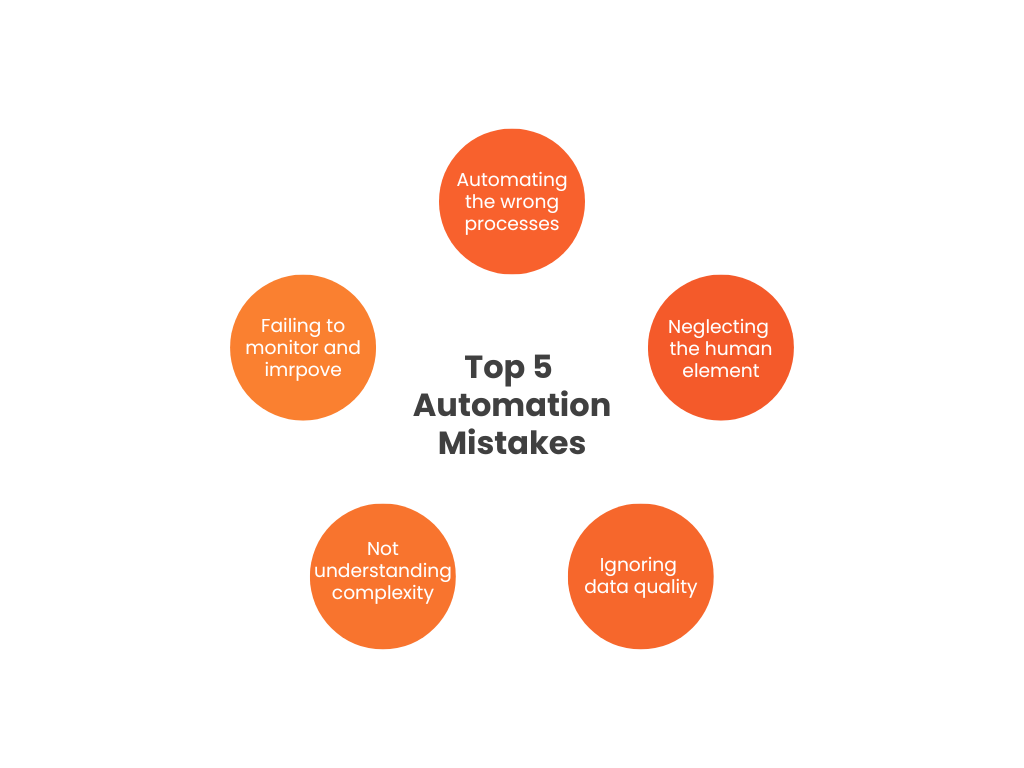Automation has become an essential aspect of modern business. But many automation greenhorns who see it as a “just-push-go” technology miss out on its unrivaled advantages.
Implementing automation is not always straightforward, and many companies make mistakes that can undermine their automation efforts. Instead of going in blindly, you’re better off knowing a thing or two about automation to avoid its common pitfalls.
Recommended: 2023 Summer Release Webinar: Automation Is Faster and Easier Than Ever
In this article, we’ll discuss:
- What happens when you automate the wrong processes
- When companies disregard the value of human interaction
- The pitfalls of ignoring data quality and analytics
- Not understanding the complexities of automation
- Not monitoring and improving automation

1. Automating the wrong processes
One of the most common automation mistakes companies make is automating the wrong processes. There’s no limit to automation’s dazzling applications. It’s easy to get wrapped up in a brilliant idea—only to be distracted by the next Product Hunt feature.
So, what types of processes might not be the best candidates for automation?
- Your core offering: Raising a garrison of machines between you and the joy of using your product or service muddies the customer connections that make your brand so inescapable. Beware automation that turns your strongest touchpoints into transactions—a flimsy relationship your competitors can easily swoop in and replicate.
- 100% of your customer service: Yes, customers want quick results and good customer service if they need help tracking an order or returning a broken item. But for more complex challenges, many customers still prefer white-glove assistance from a human and a deeper sense of customer support. For customer interactions where machines will make customers feel ignored vs. helped, automation is not always the answer.
- Expertise showcases: If you want customers to perceive you or your organization as an industry vanguard, automating interactions or content generation can degrade your authority. After all, customers are coming to you for your unique perspective.
- Complex decisioning: Some processes have a serious impact on a person’s life experience. Mortgage lending, hiring, medical diagnoses, or college applications are just a few of the examples where lone-wolf, unmonitored algorithms can sink your reputation. In one such blunder, an Amazon hiring AI built a bias against alums of the all-female Wellesley College. The HR department unwittingly dashed the job hopes of women applicants—and few knew the reasoning until someone did a little digging. Automating portions of these processes should come with a heavy dose of humans-in-the-loop automation.
Just because a task can be automated doesn’t mean it’s one that makes sense for you. Balancing utmost efficiency against the mission, strategy, and ethos of your organization is key. You must test your automation strategy.
2. Failing to Consider the Human Element
Another common automation mistake is failing to consider the human element. Some commentators see automation as a brute force elimination for human involvement. But this isn’t always the case.
For instance, avoid fully automating your core offering. Automation should help flatten the speed bumps that disrupt customer journeys, not become the very destination.
Even AI darlings like Spotify or the clothing subscription box fashionistas at StitchFix frequently tout the contributions of human experts. AI often makes a rough draft recommendation, but humans often double-check and frequently bolster its output.
Additionally, even AI tools need human-administered guardrails. In many experiments, researchers have found that AI jury-rigs the scoring system vs. finding a more innovative way to win a strategy game.
Team members are true embodiments of what your organization stands for—acing what helps you stand out from other companies who might use the same software, applications, and templates as you. Humans, mixed with a rich recipe of the right AI, can unearth new revenue streams and customer connections they’d never find alone.
3. Ignoring Data Quality
Automation relies heavily on data, and companies that ignore data quality do so at their peril. Poor data quality can lead to errors, delays, and even worse outcomes, undermining the benefits of automation. Automation’s most common data mistakes include:
- Sparing organization of unstructured data: It’s easy to lose track of hard-to-quantify documents like PDFs, presentations, handwritten notes, email threads, and more. To gain control of unstructured data, try intelligent document processing.
- Similar data exists in multiple formats: Spreadsheets and databases need just as strong of a style guide as your branding elements. For instance, typing phone numbers or state names in varying formats creates data blindness. A team member trying to pull a list of clients in the Empire State would need to know to look for ‘NY’, ‘N.Y.’, and ‘New York’. Tech, like robotic process automation, can streamline data entry to keep data clean.
- Data lives in silos: An email marketing platform contains campaign opens, YouTube houses your social media insights, and sales conversion rates are only in your ERP. One of the pillars of an effective automation strategy involves process orchestration, a concept that converges data that traditionally runs in parallel. Instead of data existing as separate jars of ingredients, your goal should be to mix them all together in an effective way—like cooking a delicious meal.
Feed your automation ecosystem with clean, reliable data for consistent, breakthrough results.

4. Underestimating the complexity of automation
Automation can be complex, and many companies underestimate the level of effort and resources required to implement automation successfully. Harvard Business Review quotes one pharmaceutical executive who racked up years of involvement in complex project roadmaps. “I’ve never actually seen one produce a result,” he lamented.
The reason? Many organization-wide initiatives are born in a boardroom or within a small team of managers. However, projects are often more complex than stakeholders predict.
Automation requires a deep understanding of your business intelligence. That includes an intimate data-driven insight into how information flows between team members and departments. Few automation strategies can survive in a silo.
Workflows include tasks performed by disparate teams and individuals—some of whom do not have a collaborative relationship. Techniques like process orchestration can help you ‘bring it all together’ to eliminate the blindspots generated by time-consuming, ineffective automation planning.
5. Failing to Monitor and Improve Automation
Finally, companies often make the mistake of failing to monitor and improve their automation efforts. Automation isn’t a “set-it-and-forget-it” strategy.
Many of your favorite management theories, like Six Sigma or Taylorism, were born in the engineering realm. In these ways of thinking, there is no endgame. Bring in new roles, alter a task sequence, initiate a new workflow, or abandon a redundant one entirely.
Processes are continually tweaked, prodded, and modified to test even better pathways to success. To foster a mindset of continuous improvement, make sure your automation strategy:
- Revolves around rock-solid performance metrics
- Quashes the fear of failure
- Involves scheduled process reviews
- Welcomes new ways of thinking by ignoring the status quo
- Targets a specific objective (that you’re open to updating when necessary!)
Leave no stone unturned! By fostering a spirit of scrutiny, you can unlock new efficiencies for your team.
Too many companies fall victim to the siren song of automation and rush the island with little forethought. After all, the technology comes with irresistible promises like improved efficiencies and drastic cost reduction—and when wielded effectively—it delivers. By following this guide, you can avoid the most common automation pitfalls and be one of the most acclaimed organizations clinching its benefits.
How does intelligent automation boost Hyper-Productivity?
Intelligent process automation (IPA) can be a game-changer for your organization in more ways than one. One of the most significant ways you can transform your workflow is by boosting Hyper-Productivity. Instead of simply being productive, your team can become Hyper-Productive, completing work faster and more efficiently than ever.
Want to use automation to your advantage? Chat with our team to learn what the best automation software is for your organization.





